There’s more to geese than just the Canada goose. In fact, there are a variety of different geese species that can be found in New Mexico. Each type of goose has its own unique set of characteristics, and it’s fascinating to learn about their different habits and habitats.
The spectacular winter migration of tens of thousands of Sandhill Cranes and Snow Geese through the Bosque del Apache National Wildlife Refuge is well-known. Waterfowl (more than a dozen bird species) winter in the nearby town of Socorro, including the Snow Goose, Ross’s Goose, and Canada Goose.
What Geese Are in New Mexico?
There are six goose species in New Mexico.
- Canada Goose
- Snow Goose
- Ross’s Goose
- Cackling Goose
- Greater White-Fronted Goose
- Brant
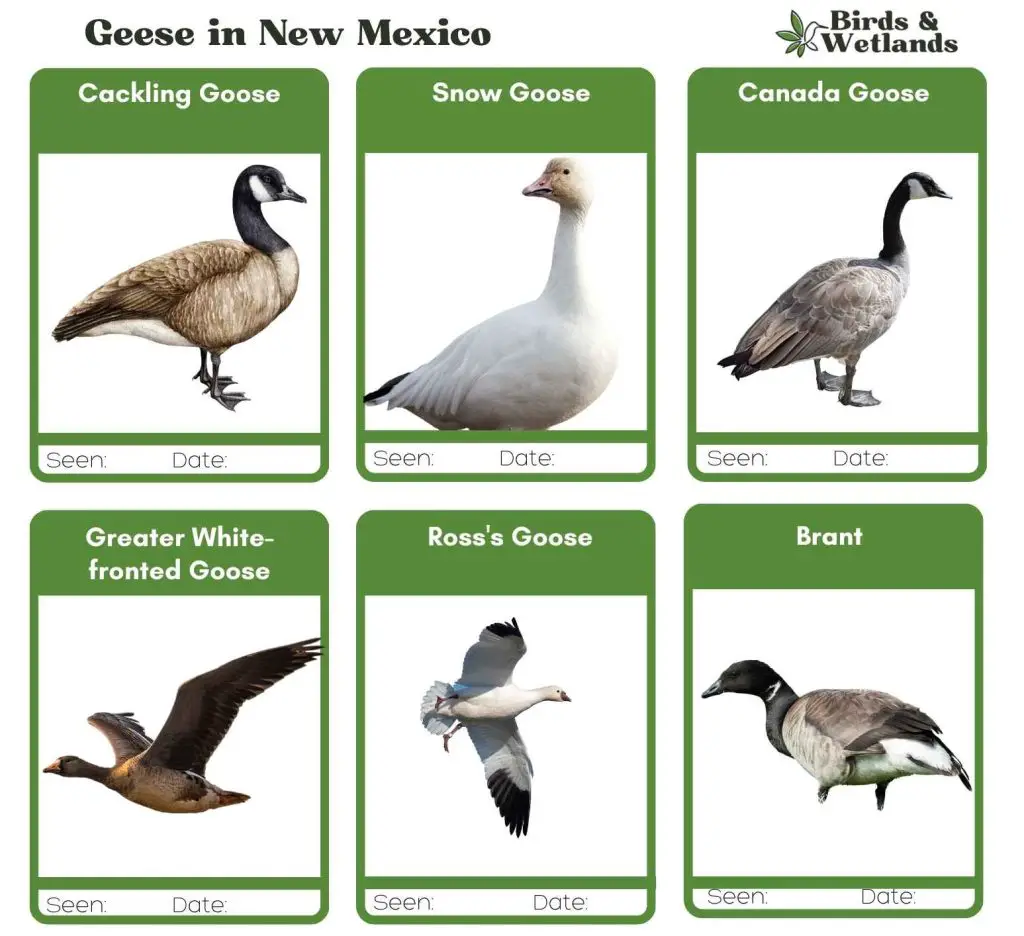
Canada Goose


Canada Goose Sound
Scientific Name: Branta canadensis
Length: 30 to 43 in
Wingspan: 50–73 in
Weight: 5.7–14.3 lb
The Canada Goose is a large, well-known species of waterfowl noted for its distinctive appearance, familiar “honk,” and migratory behavior.
Appearance: Both male and female Canada Geese have a similar appearance, featuring a black head and neck with distinctive white patches on the cheeks and chin. The body is primarily brown with a lighter, often white, underbelly.
Diet: Canada Geese primarily feed on plant matter, including grasses, aquatic vegetation, and grains. They can often be seen grazing in parks, lawns, and fields, as well as dabbling in water bodies.
Reproduction: Canada Geese typically nest on the ground near water bodies, often on islands or other isolated areas to avoid predators. The female lays a clutch of about 4 to 6 eggs, which she incubates alone for around a month.
Snow Goose

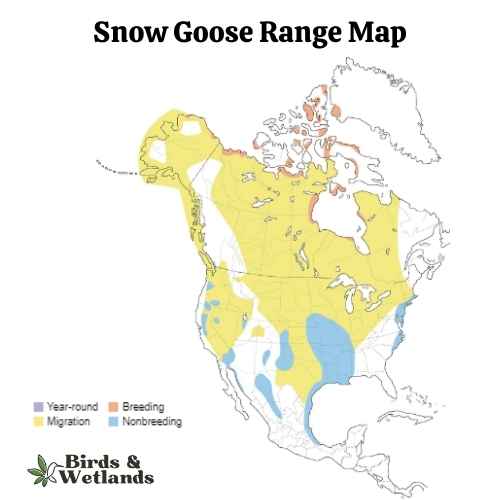
Snow Goose Sound
Scientific Name: Anser caerulescens
Length: 25 to 31 in
Wingspan: 53 to 65 in
Weight: 4.5 to 6.0
The Snow Goose is a large species of waterfowl known for its vibrant white plumage and significant migratory flights.
Appearance: True to their name, Snow Geese are predominantly white with black wingtips. They also have a pink bill, pink legs and feet. A color morph, known as the “Blue Goose,” displays a bluish-gray body with a white head, but is considered the same species.
Diet: Snow Geese primarily feed on plant matter, such as grasses, sedges, and small grains. They can often be seen in large flocks foraging in fields and marshes, and during migration and winter, they can cause considerable damage to agricultural fields due to their feeding habits.
Reproduction: Snow Geese typically nest on the tundra, near water bodies. The female builds the nest and lays a clutch of about 3 to 5 eggs, which she incubates alone for approximately three weeks. Once hatched, the goslings can feed themselves but stay with their parents for protection until they can fly.
Ross’s Goose
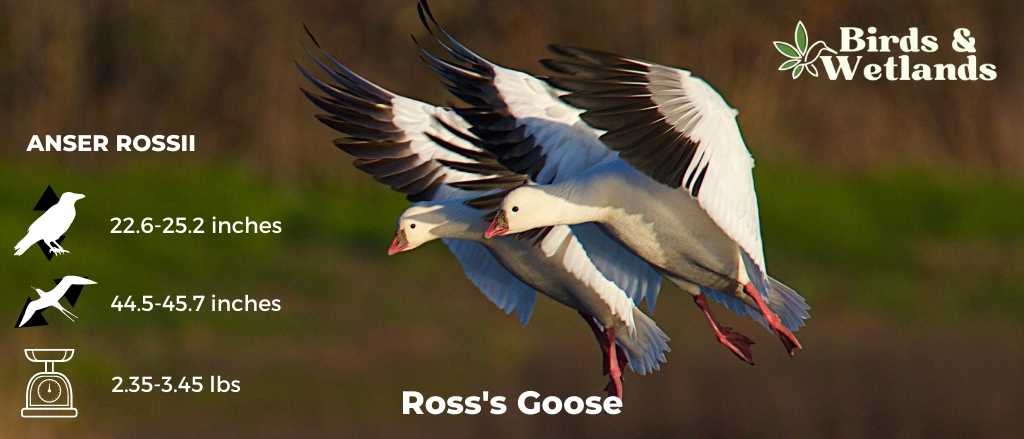
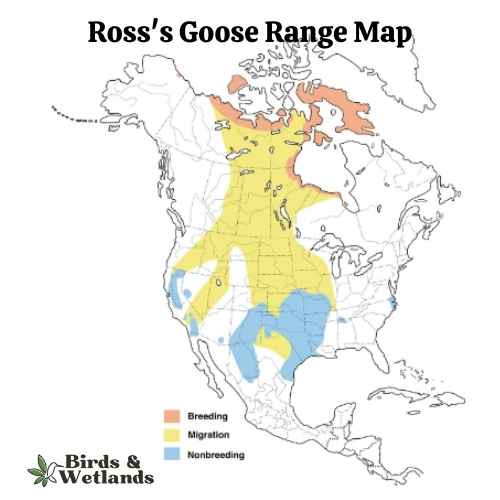
Listen
Scientific Name: Anser rossii
Length: 23.2-25.2
Wingspan: 44.5-45.7 in
Weight:42.3-55.3 oz
The Ross’s Goose is a small species of waterfowl often found in North America’s tundra and wetland habitats.
Appearance: Known for its compact size, the Ross’s Goose is mostly white with black wingtips. It features a short, stubby bill and a rounded head. One key identifying feature is the blueish gray base of its bill, which has a warty structure during the breeding season.
Diet: This goose feeds mainly on vegetation, including seeds, leaves, and roots of grasses and sedges. During winter and migration, they also consume grains and seeds from agricultural fields.
Reproduction: The Ross’s Goose nests on the ground, often in colonies. The female lays a clutch of 2 to 5 eggs which she incubates for around three weeks. The young geese, known as goslings, are precocial – they can walk, swim, and feed themselves shortly after hatching, although they stay with their parents until they learn to fly.
Cackling Goose
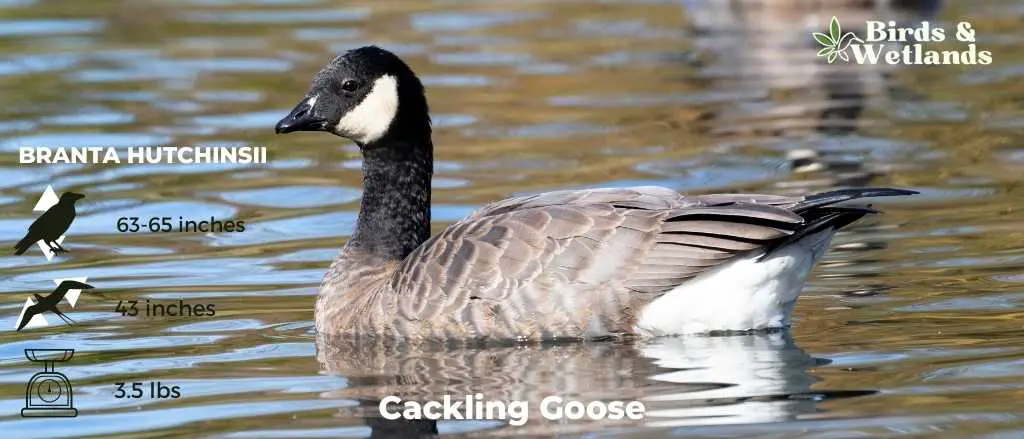
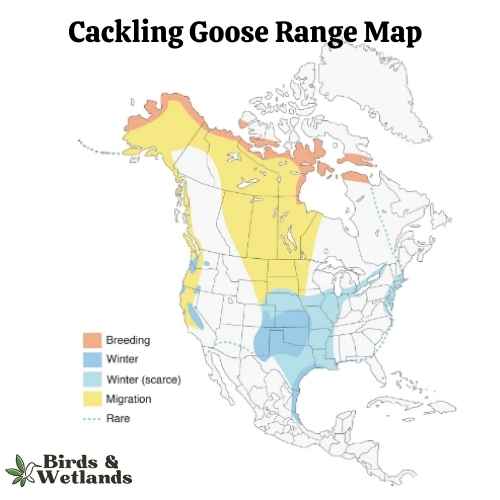
Listen
Scientific Name: Branta hutchinsii
Length: 24.8–25.6 in
Wingspan: 43-45.7 in
Weight:3.5 lbs
Cackling Geese are particularly known for their high-pitched, cackling calls, which is the source of their name. Despite their small size, these geese are renowned long-distance migrants, with some populations traveling thousands of miles between breeding and wintering grounds.
Appearance: With a similar color pattern to the larger Canada Goose, the Cackling Goose features a black head and neck, white chinstrap, light tan to cream chest, and brownish-grey body. One defining characteristic is its noticeably smaller size and stubbier neck compared to its larger counterparts.
Diet: Like many geese, the Cackling Goose’s diet mainly consists of plant matter. This includes grasses, seeds, and aquatic vegetation. They are often seen grazing on land or dabbling in shallow water.
Reproduction: Cackling Geese usually nest on the ground in elevated areas near water bodies, such as riverbanks or lakeshores. The female lays a clutch of 2 to 8 eggs and is responsible for incubation, while the male stands guard nearby. Incubation lasts for about a month.
Greater White-fronted Goose
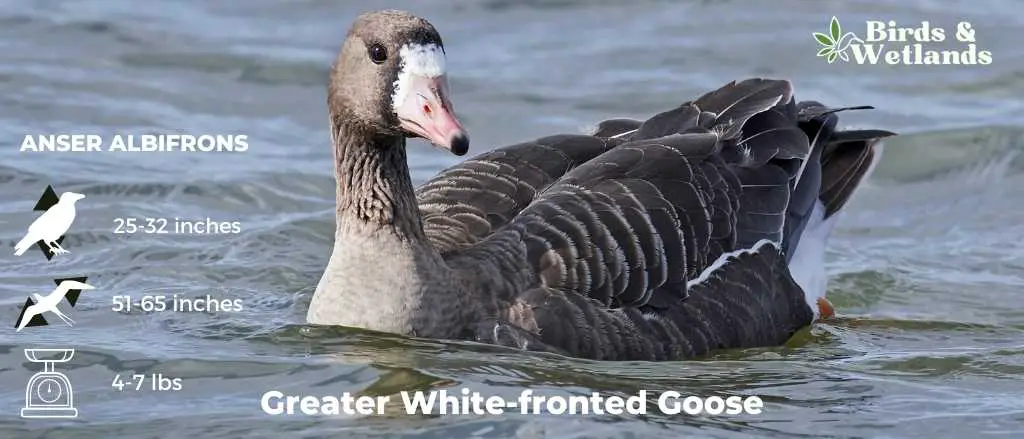

Listen
Scientific Name: Anser albifrons
Length: 25 to 31 in
Wingspan: 53 to 66 in
Weight: 3.3 to 6.6
The Greater White-fronted Goose is a medium to large waterfowl species, widely distributed across the Northern Hemisphere, particularly in North America.
Appearance: As the name suggests, these geese display a prominent white patch at the base of their bill. Their bodies are gray-brown, and their breasts are often marked with dark blotches. They possess a pinkish bill and orange legs and feet.
Diet: The Greater White-fronted Goose is a herbivore and feeds mainly on plant material. Its diet consists of grasses, sedges, grains, and berries. When wintering, these geese can often be found in agricultural fields, feasting on leftover grains and crops.
Reproduction: This species nests on the ground, often in areas with good visibility such as slopes or ridges. The female lays a clutch of 4 to 5 eggs, which she incubates for nearly a month. Once hatched, the young ones are taken care of by both parents until they are able to fly.
Brant

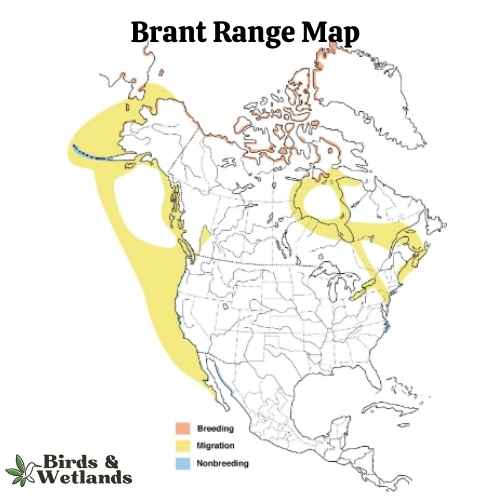
Listen
Scientific Name: Branta bernicla
Length: 22–26 in
Wingspan: 42–48 in
Weight: 1.9–4.9 lb
The Brant is a compact species of goose that is known for its striking appearance and interesting migratory patterns.
Appearance: The Brant is recognized for its dark, sooty color with a white crescent on the neck. The body is mostly black to dark gray, contrasting with the lighter underparts. Its small size, as compared to other geese, and short, stubby bill are other distinct features.
Diet: The Brant’s diet primarily consists of aquatic plants, especially eelgrass and sea lettuce. During the breeding season, they may also feed on grasses, sedges, and insects.
Reproduction: Brants typically breed in the high Arctic tundra. The female lays a clutch of 3 to 5 eggs in a ground nest, which she incubates for about a month.
Notably, Brants make an impressive long-distance migration every year. They spend their winters along both the east and west coasts of the United States and travel to the Arctic regions of Canada, Alaska, and even Russia to breed.
Are There Any Resident Flocks of Geese in New Mexico?
New Mexico is home to a variety of different wildlife, including several species of goose. Canada geese are the most common type of goose in the state, and they can be found in both urban and rural areas.
These geese typically mate for life and form large flocks, which can make them a nuisance to residents.
Canada geese are also known to eat a variety of different plants, which can cause damage to crops and gardens.
Hunting Geese in New Mexico
With the appropriate licenses and permits, it is possible to hunt geese in New Mexico.
The New Mexico Department of Game & Fish regulates hunting in the state, and they offer a variety of licenses and permits that allow hunters to target different species of game.
Can You Shoot a Goose in New Mexico?
In New Mexico, hunters are only allowed to use shotguns that are 10 gauge or smaller when hunting migratory game birds.
The shotgun must be fired from the shoulder and it can only hold up to three shells. In addition, hunters are allowed to use muzzle-loading shotguns, bows and arrows, and crossbows and bolts to take down migratory game birds.
It is important to note that all hunters must use and possess only USFWS-approved nontoxic shots when hunting any waterfowl in New Mexico.
Geese are a popular game bird in New Mexico, and there are various regulations in place to ensure a sustainable harvest. The daily bag and possession limits for geese depend on the hunting zone and flyway season.
Where Can I Hunt Geese in New Mexico?
New Mexico is home to a large number of geese, making it a popular destination for hunting enthusiasts.
The most popular hunting spots are the Bosque del Apache National Wildlife Refuge, the Las Vegas National Wildlife Refuge, the Bitter Lake National Wildlife Refuge and the Sevilleta National Wildlife Refuge.
Each of these places offers a unique hunting experience, and they are all home to a variety of different species of geese.
Is There a Goose Hunting Season in New Mexico?
Goose hunting season in New Mexico takes place from September to January. The state also has a Light Goose Conservation Order which runs from February to March.
Conclusion on Geese in New Mexico
If you’re looking for an interesting bird to watch, consider the six species of geese that can be found in New Mexico.
From the Snow Goose to the Canada Goose, these large birds are sure to delight and entertain. So next time you’re out exploring nature in New Mexico, keep your eyes peeled for some of these beautiful creatures!


